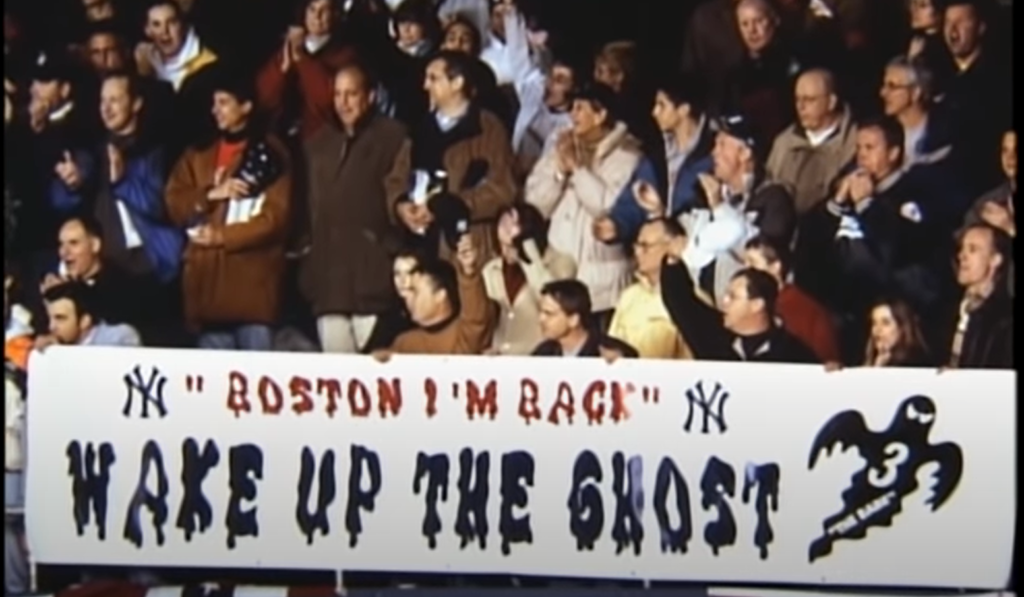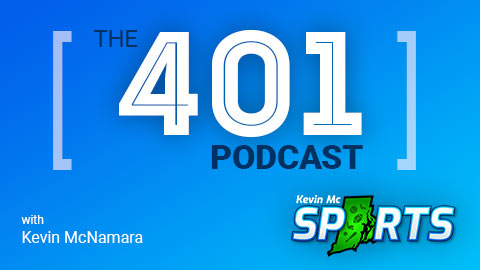Remember this nonsense? You haven’t seen it in a while . . . and you’ll never see it again. (Screenshot from You Tube)
Red Sox gifts were all the rage at Christmastime in 2004 — you don’t really have to ask why, do you? — and that year I received this from one of my friends:
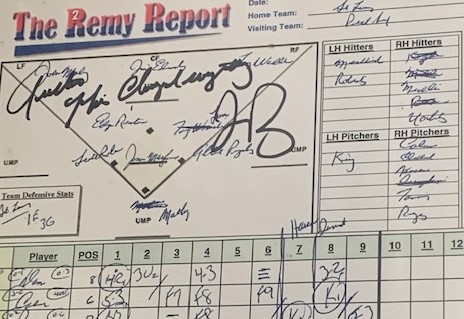
You may recall that Jerry Remy was selling signed scorecards from the Sox’ World Series-clinching triumph over the Cardinals, and he personalized — by which I mean he didn’t write the same thing on all of them — each one. On mine was: “This changed everything.”
With all due respect to Jerry, I disagree. I think this changed everything:
Red Sox-Yankees. Athens-Sparta. Hatfields-McCoys. Hard to say, really, which of those generated more heat . . . though maybe not in these parts. Around here, and 200 miles to the south, an ancient Greek conflict or a hillbilly feud had nothing on baseball’s holy war:
And all the stuff in that video, which spans 50 years, is just what happened on the field. Oftentimes it was even wilder in the stands.
The history of these two teams — and these two fan bases — have been intertwined since the sale of Babe Ruth by the Red Sox to the Yankees prior to the 1920 season. Boston had been one of baseball’s best franchises at the start of the 20th century and had been particularly dominant in the 1910s. (Four World Series titles in the decade, including three in a four-season span from 1915 to 1918.) The Yankees, meanwhile, spent those years eating Boston’s dust. They never finished first, only got closer than 11 games behind in three seasons, and finished under .500 more than half the time.
But the selling of Ruth — and the trading of other star players from the cash-strapped Sox to the rolling-in-dough Yanks — transferred a life force from Boston to New York. Starting in 1921, the Yankees embarked on the longest sustained run of success in the history of North American professional team sports: Twenty-nine first-place finishes and 20 World Series championships in 44 years. (They would add to that with two more Series titles in the 1970s, four in five seasons from 1996 to 2000, and another in 2009.) As for the pre-2004 Red Sox . . . well, we don’t have to get into that, do we?
It was through those early transactions, and the fates of the two franchises afterward, that blood hatred entered the fans’ DNA: Red Sox fans furious the Yankees had stolen their dynasty, Yankee fans knowing the beginning of their reign was Sox-fueled and they were (in a way) beholden to Boston. It lasted over the years and was passed through the generations — the enmity if not the details — and got hotter when the Yanks delivered more on-field heartbreak to the Sox in 1949 and 1978.
It’s why the rivalry lasted so long and stayed so white-hot (and, as you saw above, radiated to the players). From the Red Sox’ point of view, this was the final straw:
A lot has happened since then — most of it good for the Red Sox — but if you want to know why Grady Little will never be forgiven, there it is.
Ever watch one of those old Popeye cartoons? You know the drill: Bluto beats Popeye to a pulp, and there’ll be pieces of Popeye scattered across the floor. Then, somehow, Popeye’s corncob pipe will twirl, suck the top off a can of spinach and ingest the contents. The next thing you know, the parts of Popeye pop up and reassemble, muscles bulging as the music swells, and Popeye becomes an invincible whirling dervish. Bluto — poor, bullying Bluto — is toast.
In the Red Sox-Yankee rivalry, this is the Popeye-Bluto moment:
It was as if the instant Joe West signaled ‘safe’, there was a rip in the space-time continuum and we were transported to an alternate universe where the Red Sox were the Yankees and the Yankees were the Red Sox. For the rest of that series, the Sox got every key hit, every break, every umpire’s call; every strange stratagem worked (Curtis Leskanic on the mound with the season on the line??). The Yankees, conversely, sat back as passively over the last three games as the old Red Sox ever did — not trying to steal on Tim Wakefield in extra innings when he was so easy to run on, not bunting on Curt Schilling when he was hobbled by his ankle injury and a) would have been unable to get off the mound quickly and b) could have reinjured himself and been forced from the game.
It ended with a 10-3 victory at Yankee Stadium in Game 7. The curse was over.
And everything changed.
Over the years, always beating the Red Sox had become part of the Yankee identity. I don’t remember it being that big a thing in the 1970s, even though the players hated each other about as much as they ever did in the history of the rivalry, but it certainly was there in the 1990s, when the Yanks were again dominating baseball and the Red Sox were futilely nipping at their heels as a flawed wild-card contender. By 2003, when the teams were near-equals again, it was front and center. You couldn’t go to a Red Sox-Yankee game and not see hundreds, if not thousands, of people in shirts with ‘1918’ or ‘Killer B’s: Babe, Bucky, Buckner’ across the front. (Don’t know why they tried to take credit for Buckner, but . . . ) In the 2004 season, they added ‘Boone’ to the Killer B collection. When a glum Pedro Martinez said after losing to the Yanks in September of ’04 that he would just have to tip his hat to the Yankees “and call them my daddy,” gleeful Yankee fans thought they had an insult chant to bellow at the Sox for years to come. (They resurrected it in the 2009 World Series when Pedro was a Phillie.)
And it wasn’t just the fans. The Yankees themselves bought into it. Before Game 7 in 2004, their choice to throw out the first pitch was Bucky Dent, as if the sight of Dent and the memory of his pop fly into the screen 26 years earlier would turn the ’04 Sox into quivering heaps of Jello. (Talk about misreading the room.) I was working at the Journal that night, coordinating our coverage, and I remember saying to Bill Reynolds as Dent went out to the mound, “This is what they’re reduced to? The Red Sox have already won this thing.”
The best sports cartoon I ever saw on the topic was by our own Frank Galasso in the Journal:
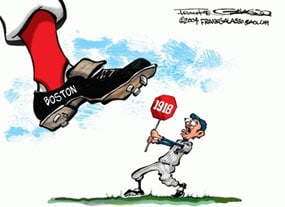
Bingo.
It was all captured perfectly by the New York Post’s Mike Vaccaro in a column last summer:
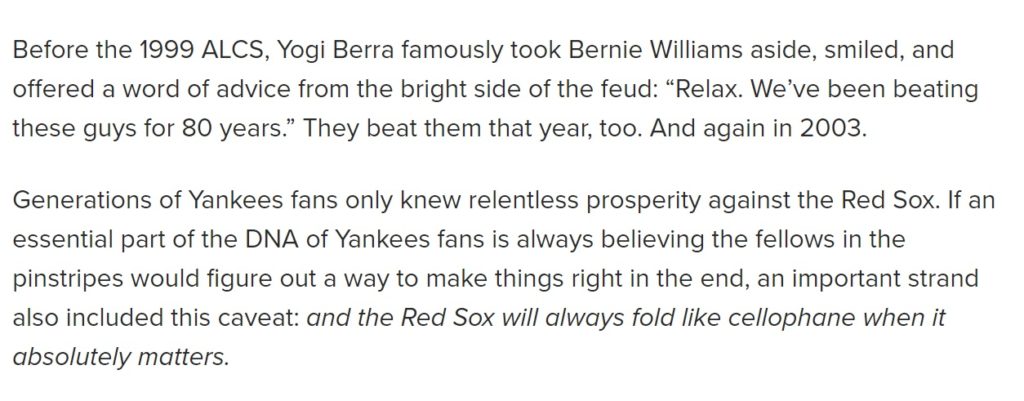
When that was no longer true, nothing else was either.
This all comes to mind because it’s a Red Sox-Yankee weekend. First meetings of the year between the surprising Sox and (so far somewhat) disappointing Yanks. Were it years ago, the anticipation would have been building all week; the coverage — even with the Bruins in the playoffs and the Celtics making the stunning announcements about Danny Ainge and Brad Stevens — would have been wall to wall. I don’t think anyone can disagree that’s not the case today.
And, really, it hasn’t been for a long time. Once the Yankee fans lost the “you never beat us when it counts” (which isn’t really true, but that’s another story for another day) and “you’ll never win the World Series” chits, it took a lot of ammo out of their arsenal. And these have taken away a lot of the angst the Red Sox fans felt regarding the Yanks:
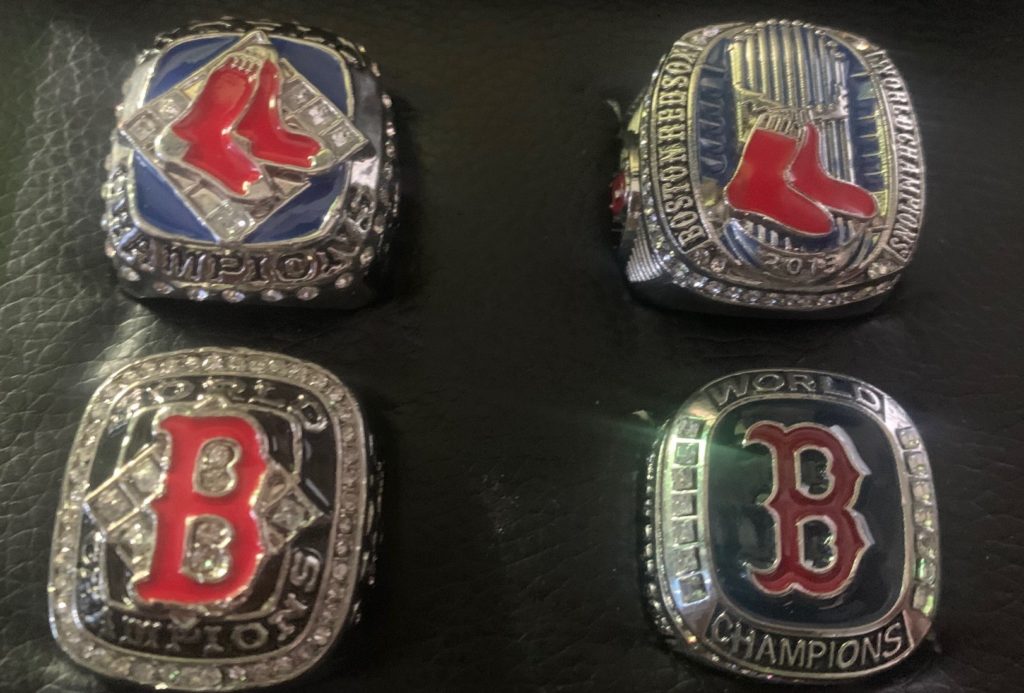
I’ve noticed how it’s changed. The garb, for one thing. I remember in 2005, the year after You Know What, I saw a guy walking around Fenway in a ‘2090’ shirt and my first thought was, “Huh??” Then it hit me: It was 86 years from 1918 to 2004, so this means it’ll be another 86 (2004 + 86 = 2090) before they win again. Except they won again in ’07, so the poor sap had to toss it into the same rag pile as his ‘1918’ and ‘Killer B’ shirts. Then there was the ‘Got Rings?’ attempt, which compared the number of rings collected by the Yankees to the number collected by the Red Sox. But the Sox kept winning, which forced them to make new shirts every couple of years, so eventually that faded away too.
But it’s more than that. After 2004, the Red Sox and Yankees didn’t meet in the playoffs for 14 years. In that stretch the heat got turned down, just as it had during other periods when one or both of the teams wasn’t that good. I kept thinking the spark would reignite when, once more, they were strong at the same time and finally faced each other again in the postseason . . . but it didn’t. I know it’s just my sense of it, but I lived through the ’70s. And the ’90s. And the early 2000s. 2018 wasn’t the same. Their ALDS meeting that year was nothing more than a step on the Red Sox’ climb to another World Series championship. With the exception of Brock Holt hitting for the cycle (and maybe Aaron Judge playing “New York New York” on a tape machine as he made his way past the Red Sox clubhouse after Game 2), nothing in that series matched the intensity or excitement of the Sox’ subsequent conquests of the Astros and Dodgers.
And I realized why. The Yankees have forever lost their aura of invincibility against Boston, which had become a huge part of the Yankee fan’s self-identity. And the Red Sox have forever lost their sense of predestined failure against New York, which kept Sox fans from ever shedding the worry of impending doom.
They’re different now. They’re equals. It’s a whole new dynamic.
It may not be as dramatic or exciting as it once was. But I like it this way.
Art Martone wrote a Red Sox-based Internet baseball column for projo.com, for which he was named Best Sports Columnist by Boston Magazine in 1998. He also wrote about baseball for the Providence Journal and has had Red Sox material published in several baseball-only publications. He worked at the Journal from 1974 to 2009 and was Sports Editor from 2000 until leaving in 2009 to become Managing Editor of NBC Sports Boston’s Web site. He remained there until his retirement in 2019.

